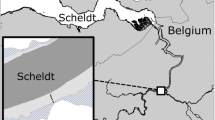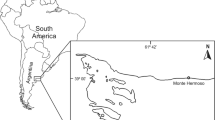Abstract
In the early 1990’s a conspicuous shift took place in the density of two key macrofauna species at the Frisian Front (SE North Sea). The density of the formerly dominant brittlestar Amphiura filiformis showed tenfold reduction and remained low throughout the observation period (1986–2000). In the same period, the burrowing mud shrimp Callianassa subterranea showed a fourfold increase in density. Since the Frisian Front is a transition area where tidal currents fall just below the erosion threshold of silt and bioturbating mud shrimps can potentially affect the sediment erosion threshold, we examined the effects of the species on sediment erodibility. Two experiments were conducted in laboratory annular flumes. In the first experiment we compared the effects of pre-shift and post-shift combinations of the two species on the erodibility of Frisian Front sediment. The results indicated that the erosion was facilitated by a combination of high densities of C. subterranea and low densities of A. filiformis, representing the situation in the late 1990s. The difference in erodibility was already apparent at velocities equal to the critical near-bed current speed measured at the Frisian Front. In the second experiment the effects of pre- and post-shift densities of A. filiformis on sediment erodibility were compared. This showed that low A. filiformis densities as found in the late 1990’s facilitate erosion, but the effect is only significant at velocities above the critical near-bed velocity in the field. At the latter velocity, no significant difference in erodibility was found between the two A. filiformis densities. This implies that the difference in turbidity in the first experiment was mainly due to the activity of C. subterranea. The experimental results indicate that resuspension at the Frisian Front may occur more frequently as a result of the shift towards a Callianassa dominated community. More frequent resuspension of bottom sediment, most likely amplified by the climate induced increase of wind strength in the North Sea, may hamper the recovery of the A. filiformis adult population.







Similar content being viewed by others
References
Aller, J., 1997. Benthic community response to temporal and spatial gradients in physical disturbance within a deep-sea western boundary region. Deep Sea Research Part I 44: 39–69.
Amaro, T., 2005. The benthic shift of the Frisian Front (southern North Sea) ecosystem—possible mechanisms. PhD Thesis, Wageningen University, The Netherlands: 1–201.
Amaro, T., G. Duineveld, M. Bergman & R. Witbaard, 2003. Growth variations in the bivalve Mya truncata: a tool to trace changes in the Frisian Front macrofauna (southern North Sea)? Helgoland Marine Research 57: 132–138.
Archambault, M.-C., M. Bricelj, J. Grant D. & M. Anderson, 2004. Effects of suspended and sedimented clays on juvenile hard clams, Mercenaria mercenaria, within the context of harmful algal bloom mitigation. Marine Biology 144: 553–565.
Bock, M. M. & D. C. Miller, 1997. Particle-bound organic matter as a cue for suspension feeding in tentaculate polychaetes. Journal of Experimental Marine Biology and Ecology 215: 65–80.
de Brouwer, J. F. C., K. Wolfstein, G. K. Ruddy, T. E. R. Jones & L. J. Stal, 2005. Biogenic stabilisation of intertidal sediments: the importance of extracellular polymeric substances produced by benthic diatoms. Microbial Ecology 49: 501–512.
Coleman, F. C. & S. L. Williams, 2002. Overexploiting marine ecosystem engineers: potential consequences for biodiversity. Trends in Ecology and Evolution 17: 40–44.
Cramer, A., 1990. Seasonal variation in benthic metabolic activity in a frontal system in the North Sea. In Barnes M. & R.N. Gibson (eds), Trophic Relationship in the Marine Environment. Proceedings of the 24th Europ. Mar. Biol. Symp. Aberdeen Universit press, Aberdeen: 54–76.
Creutzberg, F., 1985. A persistent chlorophyll a maximum coinciding with an enriched benthic zone. In Gibbs P. E. (ed.), Proceedings of the 19th European Marine Biology Symposium, Cambridge University Press, Londen: 97–108.
Creutzberg, F. & H. Postma, 1979. Experimental approach to the distribution of mud in the southern North Sea. Netherlands Journal of Sea Research 13: 99–116.
Creutzberg, F., P. Wapenaar, G. Duineveld & N. Lopez-Lopez, 1984. Distribution and density of the benthic fauna in the southern North Sea in relation to bottom characteristics and hydrographic conditions. Rapports et Proces-verbaux Reunion du Conseil International Exploration du Mer 183: 101–110.
Daan, R. & M. Mulder, 2005. The macrobenthic fauna in the Dutch sector of the North Sea in 2004 and a comparison with previous data. NIOZ-Rapport 2005: 1–95.
De Haas, H. & T. C. E. Van Weering, 1997. Recent sediment accumulation, organic carbon burial and transport in the northeastern North Sea. Marine Geology 136: 173–187.
Duineveld, G. C. A. & G. J. van Noort, 1986. Observations on the population dynamics of Amphiura filiformis (Ophiuroidea Echinodermata) in the southern North Sea and its exploitation by the dab Limanda limanda. Netherlands Journal of Sea Research 20: 85–94.
Duineveld, G. C. A. & A. R. Boon, 2002. Short-term variations in fluxes and composition of seston in near-bottom traps in the southern North Sea. Helgoland Marine Research 56: 140–148.
Flach, E. C., (1992). Disturbance of benthic infauna by sediment reworking activities of the lugworm Arenicola marina. Netherlands Journal of Sea Research 30: 81–89.
Jago, C. F., S. E. Jones, R. J. Latter, R. R. McCandliss, M. R. Hearn & M. J. Howarth, 2002. Resuspension of benthic fluff by tidal currents in deep stratified waters, northern North Sea. Journal of Sea Research 48: 259–269.
Jones, C. G., J. H. Lawton & M. Shachak, 1994. Organisms as Ecosystem Engineers. Oikos 69: 373–386.
Jähmlich, S., L. C. Lund-Hansen & T. Leipe, 2002. Enhanced settling velocities and vertical transport of particulate matter by aggregation in the benthic boundary layer. Danish Journal of Geography (Geografisk Tidsskrift) 102:37–49.
Kaiser, M. J., K. Ramsay, C. A. Richardson, F. E. Spence & A. R Brand, 2000. Chronic fishing disturbance has changed shelf sea benthic community structure. Journal of Animal Ecology 69: 494–503.
Kröncke, I., T. Stoeck, G. Wieking & A. Palojarvi, 2004. Relationship between structural and functional aspects of microbial and macrofaunal communities in different areas of the North Sea. Marine Ecology Progress Series 282: 13–31.
Lindeboom, H. J., G. Kessel & L. Berkenbosch, 2005. Gebieden met bijzondere ecologische waarden op het Nederlandse Continentaal Plat. Rapport RIKZ/2005.008, Alterra Rapport nr. 1109: 1–104.
Loo, L. O., P. R. Jonsson, M. Sköld & O. Karlsson, 1996. Passive suspension feeding in Amphiura filiformis (Echinodermata: Ophiuroidea): feeding behaviour in flume flow and potential feeding rate of field populations. Marine Ecology Progress Series 139: 143–155.
Maa, J. P. Y., L. D. Wright, C.-H. Lee & T. W. Shannon, 1993. Vims sea carousel: a field instrument for studying sediment transport. Marine Geology 115: 271–287.
Marinelli, R. & S. A. Woodin, 2002. Experimental evidence for linkages between infaunal recruitment, disturbance, and sediment surface chemistry. Limnology and Oceanography 47: 221–229.
Meadows, P. S., J. Tait & S. A. Hussain, 1990. Effects of estuarine infauna on sediment stability and particle sedimentation. Hydrobiologia 190: 263–266.
Nicholls, P., J. Hewitt & J. Halliday, 2003. Effects of suspended sediment concentrations on suspension and deposit feeding marine macrofauna. Auckland Regional Council Technical Publication 211: 1–40.
Rhoads, D. C. & D. K. Young, 1970. The influence of deposit-feeding organisms on sediment stability and community trophic structure. Journal of Marine Research 28: 150–178.
Rowden, A. A., C. F. Jago & S. E. Jones, 1998a. Influence of benthic macrofauna on the geotechnical and geophysical properties of surperficial sediment, North Sea. Continental Shelf Research 18: 1347–1363.
Rowden, A. A., M. B. Jones & A. W. Morris, 1998b. The role of Callianassa subterranea (Montagu) (Thalassinidea) in sediment resuspension in the North Sea. Continental Shelf Research 18: 1365–1380.
Scheffer, M., R. Portielje & L. Zambrano, 2003. Fish facilitate wave resuspension of sediments. Limnology and Oceanography 48: 1920–1926.
Schroeder, A., 2003. Community dynamics and development of soft bottom macrozoobenthos in the German Bight (North Sea) 1969–2000. PhD thesis, University Bremen: 1–265.
Siegismund, F. & C. Schrum, 2001. Decadal changes in the wind forcing over the North Sea. Climate Research 18: 39–45.
Sköld, M. & J. S. G. Gunnarsson, 1996. Somatic and germinal growth of the infaunal brittle stars Amphiura filiformis and A-chiajei in response to organic enrichment. Marine Ecology Progress Series 142: 203–214.
Solan, M. & R. Kennedy, 2002. Observation and quantification of in situ animal-sediment relations using time-lapse sediment profile imagery (t-SPI). Marine Ecology Progress Series 228: 179–191.
Stamhuis, E. J., C. E. Schreurs & J. J. Videler, 1997. Burrow architecture and turbative activity of the thalassinid shrimp Callianassa subterranea from the central North Sea. Marine Ecology Progress Series 151: 155–163.
Urrutia, M. B., J. I. P. Iglesias, E. Navarro & J. Prou, 1996. Feeding and absorption in Cerastoderma edule under environmental conditions in the Bay of Marennes-Oleron (western France). Journal of the Marine Biological Association of the United Kingdom 76: 431–450.
Van der Wegen, M., 2005. Coastal and river engineering support system. http://www.waterbouw.tudelft.nl/public/ct4310/cress/cress.htm.
Widdows, J., A. Blauw, C. H. R. Heip, P. M. J. Herman, C. H. Lucas, J. J. Middelburg, S. Schmidt, M. D. Brinsley, F. Twisk, & H. Verbeek, 2004. Role of physical and biological processes in sediment dynamics of a tidal flat in Westerschelde Estuary, SW Netherlands. Marine Ecology-Progress Series 274: 41–56.
Widdows, J. & M. Brinsley, 2002. Impact of biotic and abiotic processes on sediment dynamics and the consequences to the structure and functioning of the intertidal zone. Journal of Sea Research 48: 143–156.
Williams, J. J., J. D. Humphery, P. J. Hardcastle & D. J. Wilson, 1998. Field observations of hydrodynamic conditions and suspended particulate matter in the southern North Sea. Continental Shelf Research 18: 1215–1233.
Witbaard, R., G. C. A. Duineveld & M. J. N. Bergman, 2001. The effect of tidal resuspension on benthic food quality in the southern North Sea. Senckenbergiana Maritima 31: 225–234.
Witbaard, R. & G. Duineveld, 1989. Some aspects of the biology and ecology of the burrowing shrimp Callianassa subterranea (Montagu) (Thalassinidae) from the southern North Sea. Sarsia 74: 209–219.
Witbaard, R., G. C. A. Duineveld, T. Amaro & M. J. N. Bergman, 2005. Growth trends in three bivalve species indicate climate forcing on the benthic ecosystem in the south eastern North Sea. Climate Research 30: 29–38.
Wolters, M., J. P. Bakker, M. D. Nertness, R. L. Jefferies & I. Möller, 2005. Saltmarsh erosion and restoration in south-east England: squeezing the evidence requires realignment. Journal of Applied Ecology 42: 844–851.
Woth, K., R. Weisse & H. von Storch, 2005. Climate change and North Sea storm surge extremes: an ensemble study of storm surge extremes expected in a changed climate projected by four different regional climate models. Journal Ocean Dynamics 56: 3–15.
Ziervogel, K. & B. Bohling, 2003. Sedimentological parameters and erosion behaviour of submarine coastal sediments in the south-western Baltic Sea. Geo-Marine Letters 23: 43–52.
Acknowledgements
We would like to specially thank John Beijer for giving support in the use of the Hydrocopter and for all the cooperation offered. We thank Sanne Schulting for her assistance during field trips and her substantial contribution to the laboratory experiments. The crew of RV Pelagia and all the volunteers are acknowledged for their help in collecting the samples. This study was supported by a grant awarded by Fundação Para a Ciência e Tecnologia (FCT) and Fundo Social Europeu (FSE) to Teresa Amaro.
Author information
Authors and Affiliations
Corresponding author
Additional information
Handling editor: K. Martens
Rights and permissions
About this article
Cite this article
Amaro, T.P.F., Duineveld, G.C.A., Bergman, M.J.N. et al. The consequences of changes in abundance of Callianassa subterranea and Amphiura filiformis on sediment erosion at the Frisian Front (south-eastern North Sea). Hydrobiologia 589, 273–285 (2007). https://doi.org/10.1007/s10750-007-0750-2
Received:
Revised:
Accepted:
Published:
Issue Date:
DOI: https://doi.org/10.1007/s10750-007-0750-2




